I hardly slept through the night, it was hot and clammy, even with a fan blowing overhead.
At first light I arose and invigorated myself with a cold shower before heading up to the roof for breakfast. It was the usual Tanzanian breakfast fare: fruit juice, a selection of fruit which normally included banana, mango and water melon, and eggs cooked to order plus limitless coffee. Just before starting my omelette I poured chilli sauce on the side of the plate, and then to start my day off properly, the lid of the sauce bottle flew off and I ended up with a bottle full of chilli sauce with my omelette. Yum!! The Israeli girl next to me was highly amused. I learned she was undertaking voluntary work in Ethiopia, and was now taking a little time out to visit Uganda and Tanzania.
Dan and Sally later joined me for breakfast, and then off we went in a minibus heading for one of the farmlands northeast of Stone Town for a spice tour.

Fresh Turmeric, Tastes Like Ginger
|
On the way, we picked up Tyler and Alison. Tyler had not long graduated in South Dakota, and after a brief spell in journalism, had come out to Zambia to undertake a 27 month voluntary stint involving starting up new plantations such as banana. He had 18 months left to go. The lad was pretty fit, and had recently completed the Kilimanjaro marathon in three hours. Alison hailed from Michigan, and worked with Tyler in Zambia supporting a fishermen's cooperative.
Our guide for the tour was Ozum, who introduced himself as, "Ozum. Some people call me awesome," and with that he burst into peals of laughter. He was a friendly Zanzibari who grew up in Stone Town. Ozum had learnt about spices and plants in school, and had gained considerable knowledge on the subject from his parents and grandparents. He had been in the job for two years now.

Pomelo
|
Spices on Zanzibar date back as far as the 16th century, when the Portuguese had a foot-hold on the island. They imported various plants and spices from their colonies in South America and India, and land was cleared for their cultivation. The Portuguese, however, were more interested in securing sea bases for their trading routes than agriculture. It was really the Omanis, who ruled Zanzibar from the early 19th century, and realised the potential of the hot climate combined with regular rainfall, who developed spice production as an entity. The demise of the slave trade in the late 19th century rendered spices as Zanzibar's main source of income. Spice production on the island is no longer as prominent as it used to be, but for the ordinary people of Zanzibar, the spices and useful plants are a vital part of everyday life and a rich element in the island's strong and vibrant culture.

Ginger
|

Nutmeg with a Waxy Red Covering of Mace
|
Ozum led us through a glade of mahogany and 23 year-old teak, and past a cassava plant, the third-largest source of food carbohydrates in the tropics, and a green orange tree (no, the oranges are green in colour). An orange is not a naturally occurring fruit , but rather a crossbreed of the tangerine and the pomelo. The reason why oranges are green in a tropical climate is because the weather rarely gets cold. Because of the lack of cool weather, the chlorophyll remains in the skin of the orange, keeping it green. When an orange is exposed to cool weather while still on the branch it turns to orange. And orange that is left on the tree can change between green and orange several times depending on the weather.
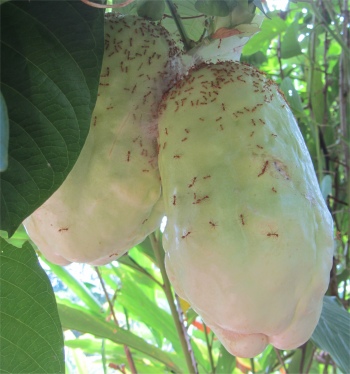
Passion Fruit with Ants
|
He then scratched away near the base of a plant, and pulled up a rhizome, which he cut in two to reveal a succulent yellow spice, turmeric. We tried a small piece each, and it tasted of ginger. I had never realised the spice, which I had only seen in powder form until then, was a member of the ginger family. I mentioned to Ozum that turmeric is used a lot in Indian cooking, and it has also been discovered that Indians seem to suffer Alzheimer's far less than other nationalities, leading to scientists investigating whether turmeric could be used to counteract the disease.
A short walk further on brought us to a group of pomelo hanging from a tree. The pomelo, which is a fruit, is also known as the Chinese grapefruit. Nearby stood a ginger plant with its rhizomes poking above the soil. Also known as the poor man's Viagra, no prizes for guessing what it also functions as on Zanzibar. Ginger, like turmeric has medicinal properties in addition to its culinary uses.

Cocoa
|
We continued to an avocado or alligator pear tree. The avocado is a climacteric fruit (the banana is another), which means it matures on the tree, but ripens off the tree.
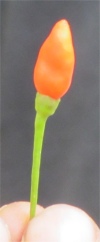
Pili Pili (Chilli)
|
Ozum plucked a small green fruit off a tree, and cut it open to reveal nutmeg. As well as its medical and culinary uses, Zanzibarian women often mix nutmeg with porridge. Nutmeg is for women as turmeric is for men; it is often used as a sex-stimulating spice for women who have either lost their passion or could do with a little help. Another interesting fact is that nutmeg is the only tropical fruit that is the source of two different spices. Mace is a spice made from the waxy red covering that surrounds nutmeg seeds. The flavour is similar to that of nutmeg, with a hint of pepper and a more subtle note which can be overwhelmed by heavy-handed cooks.

Pineapple
|
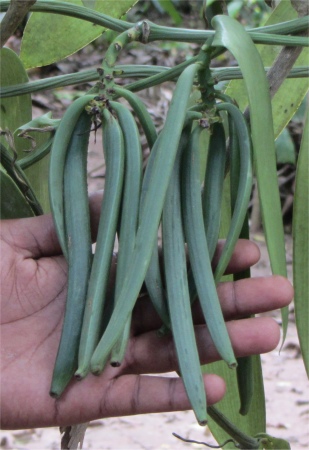
Vanilla Pods
|
Tiny red "peppers" were introduced to us as pili pili, the Swahili word for "pepper pepper". The pili pili fruit is actually African bird's eye chilli.
We strolled past passion fruit and cardamom plants before arriving at clump of cocoa pods hanging down from a tree, one of which Ozum removed and cut in two to reveal cocoa beans. A pod typically contains 30 to 40 seeds, each of which is surrounded by a bitter-sweet white pulp. In the wild the seeds are dispersed and eaten by different mammals like monkeys. When the seeds are dried and fermented in the sun they are brownish red, and known as cocoa beans.
We came across pineapple, named for its resemblance to the pine cone, and vanilla pods. Vanilla is the second most expensive spice after saffron, because growing the vanilla seed pods is labour-intensive due to the hand pollination required. Alongside we crossed paths with a star fruit tree, with its fruit dangling down with their five distinctive ridges running down its sides, in cross-section resembling a star - obviously. Ozum told us that these trees grow in the wild on the island.

Star Fruit
|

Cinnamon Tree
|
One unusual fruit I came across was the annatto, the seed of the achiote tree, used as a dye, in medicine, and as an ingredient in many foods. Annatto is a naturally intense dye which can range in colour from bright yellow to deep orange. One of Ozum's sidekicks squeezed the annatto of this tree, producing a strong, vibrant red, which is often used in lipstick. As illustration, the sidekick rubbed a smidgeon of the powerful red die on his lips; it really was a potent colour. The same sidekick had a limited knowledge of English, mainly limited to "lovely jubbly". Apparently he had been taught English for a short while at school, and his teacher was on a mission to teach Cockney rhyming slang.
Ozum walked us up to a tree, from which he cut a small vertical strip of bark. He gave us each a small piece of the bark and asked us to scrape the fleshy side with our teeth. Wow, the taste was sensational, it was quite sweet but unmistakably cinnamon. Commercially, the inner bark is prised out in long rolls. Only the thin inner bark is used, the outer, woody portion is discarded, leaving metre-long cinnamon strips. The strips must be processed immediately after harvesting while still wet. Once processed, the strips will dry completely and curl into rolls ("quills") in four to six hours. Cinnamon has been known from remote antiquity, and it was so highly prized among ancient nations that it was regarded as a gift fit for monarchs and even for a god; it was used as currency, and it has aphrodisiacal powers (crumbs, imagine what you'd get if you combined ginger, nutmeg and cinnamon). In the first century A.D., Pliny the Elder wrote of 350 grams of cinnamon as being equal in value to over five kilograms of silver, about fifteen times the value of silver per weight. Ozum mentioned that ants can't stand it, and it is used locally to treat gingivitis. He also retrieved and crushed some of the roots for us to smell; the odour was methanol.

Annatto
|

Aloe
|

Cloves
|
The next plant we stumbled across was an aloe with its large, thick, spiny, fleshy leaves. The most widely known species is Aloe vera, or "true aloe", so called because, though probably extinct in the wild, it is cultivated as the standard source of so-called "aloe vera" for assorted pharmaceutical purposes. I first came across the latter variety many years ago in the Canary Islands, where the internal liquid was applied to my wife's sunburn, with amazing results. The transparent gel from the pulp of the meaty leaves of aloe vera has been used topically for thousands of years to treat wounds, skin infections, burns, and numerous other dermatologic conditions. Ozum mentioned that the liquid oozing from a cut leaf is exceedingly bitter. Being a fool I tried it, and he was not joking, strong enough to remove the skin of your teeth.

Coffea Arabica
|
Further along our trail we discovered a Coffea Arabica shrub with berries. The history of coffee is quite fascinating. Coffee use can be traced at least to as early as the ninth century, when it appeared in the highlands of Ethiopia. According to legend, Ethiopian shepherds were the first to observe the influence of the caffeine in coffee beans when the goats appeared to "dance" and to have an increased level of energy after consuming wild coffee berries. The legend names the shepherd "Kaldi." Kaldi dutifully reported his findings to the abbot of the local monastery who made a drink with the berries and discovered that it kept him alert for the long hours of evening prayer. Soon the abbot had shared his discovery with the other monks at the monastery, and ever so slowly knowledge of the energizing effects of the berries began to spread. As word moved east and coffee reached the Arabian Peninsula, it began a journey which would spread its reputation the world over. From Ethiopia, coffee spread to Egypt and Yemen. It was in Arabia that coffee beans were first roasted and brewed, similar to how it is done today. By the 15th century, it had reached the rest of the Middle East, Persia, Turkey, and northern Africa. Its popularity was perhaps due, in part, to the fact that Muslims, forbidden alcoholic drink by the Koran, found coffee's energizing properties to be an acceptable substitute. From the Muslim world, coffee spread to Italy, then to the rest of Europe, to Indonesia, and to the Americas. Coffea arabica is believed to be the first species of coffee to be cultivated, being grown in southwest Arabia for well over 1,000 years.

Ylang-Ylang
|
In the vicinity of the coffee shrub was a clove tree. Cloves are the highly aromatic dried flower buds of a tree that has been used for food and medicine for centuries. In addition to its culinary purposes, clove oil is used in preparation of some toothpastes, laxative pills and Clovacaine solution which is a local anaesthetic and used in oral ulceration and anti-inflammations.
A curry leaf tree was close at hand, a fast-growing deciduous small tree with deep roots and scented leaves. The highly aromatic leaves are valued as seasoning in curries. Nearby was a tree, whose name I forget, but when cut with a sharp knife, oozed a liquid that contained a high concentration of iodine.
Moving on, we came to a tree that is valued for its perfume, the ylang ylang tree. Ylang ylang's scent is intensely sweet, slightly spicy and has a hint of banana. The essential oil derived from the flowers is thought to be an aphrodisiac and is used in aromatherapy. Modern science considers the ylang ylang flower to be a mental stimulant, though aroma therapists regard its essential oil as a powerful sedative. Either way, it is known that just getting a whiff of this flower's scent is enough to cause a drop in blood pressure. Ozum mentioned that Chanel use this flower in their perfumes.
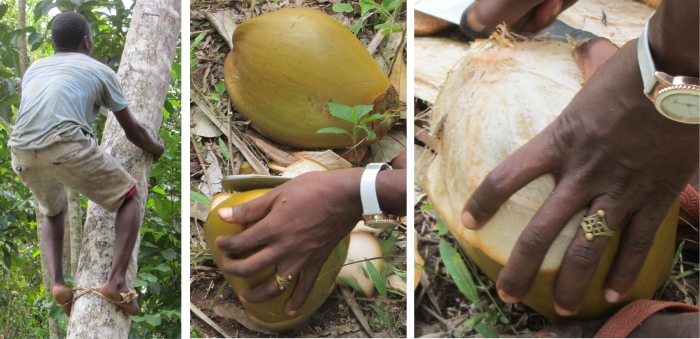
Coconut Gathering and Preparation
|
This brought us to a grove of coconut trees. Ozum's sidekick tied a piece of twine between his ankles and proceeded to climb, with his legs bound in this manner, up one of the trees, singing as he did so in a lilting chorus. Once at the top, he cut off two of the fruit and tossed them to the ground, and quickly returned to
terra firma after doing so. He then proceeded to pare away the husk with his sharp machete, then lopped off the tops, and passed them around so that we could all sample the sickly sweet juice inside. When we had drained them, he extracted the soft white flesh from inside, and we all had a taste. I found this too soft and sickly sweet for my palate. I was more used to the hard coconut flesh encountered on those won from U.K. fairgrounds. What were wondrous to behold were the hens and chicks that appeared from nowhere, and had an affinity to the sweet soft flesh tit-bits discarded on the ground.

Coconut Juice Tasting
|
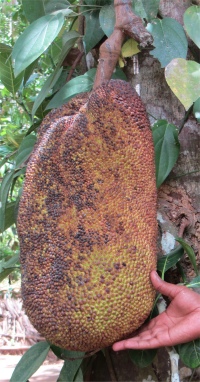
Jackfruit
|
The last fruit we came across was the jackfruit, enormous and prickly on the outside, indeed it is the biggest fruit on the island. Once a jackfruit is cracked open, pods or "bulbs" are revealed inside. Often referred to as seeds, these bulbs are actually a kind of fleshy covering for the true seeds or pits, which are round and dark like chestnuts. The fleshy part (the "bulb") can be eaten as is, or cut up and cooked. When unripe (green), it is remarkably similar in texture to chicken, making jackfruit an excellent vegetarian substitute for meat. In fact, canned jackfruit (in brine) is sometimes referred to as "vegetable meat". We didn't cut one open, but Ozum quoted a saying: "smells like hell, tastes like heaven." None of us fancied trying it.
After our tour, Ozum took us to a covered area with a colourful raffia mat laid out on the floor, on which a freshly prepared meal was spread out before us. We were directed to remove our shoes, sit down on the mat, and partake in the sumptuous feast presented before us. It was a most enjoyable meal, standard Zanzibarian vegetarian fare eaten on the floor as a sultan would have eaten, and it gave us the chance to chat more with Ozum, Tyler and Alison.
On our journey back to Stone Town, Tyler and Alison hopped off at Bububu to transfer to a different minibus. They were heading off to Nungwi for a couple of days. We acquired new passengers here, one a lad from Surrey who was doing voluntary work in Mombasa. The other new fellow travellers were a San Franciscan couple who were on their annual two week vacation. The chap was a mechanical engineer, and had never visited Europe. Neither had Tyler or Alison for that matter. I thought that odd since I presumed most Americans wanted to do the grand European tour. Maybe times have changed. Ozum had no ambitions to leave Africa, his only ambition being to visit Egypt.

Anglican Cathedral or Cathedral Church of Christ
|
Once back at base, we visited some of the backstreet shops for souvenirs, and then, after getting Sally ensconced in Livingstone's, Dan and I headed across the "dark interior" of Stone Town's bazaar of narrow alleyways to visit the Slave Market at the Anglican Cathedral or Cathedral Church of Christ.

Cross Dedicated to David Livingstone
|
Apart from its grandeur, the cathedral's noted for its location, since it was built on the site of the island's notorious slave market. Work on the construction of the cathedral was started in 1873 by Edward Steere, the third Bishop of Zanzibar and famous British slave abolitionist, and the same year the slave market was closed. Its construction is Basilican in type and a mixture of Gothic and Arabic in style, and its strange barrel vault roof, constructed of Portland cement and crushed coral, was Steere's own invention. Sultan Barghash donated the cathedral's clock on the condition that the spire did not exceed the height of the House of Wonders. The result was a dwarf spire on top of a hefty nave. The construction took ten years to complete. Bishop Steer died in 1882 and was buried behind the altar.
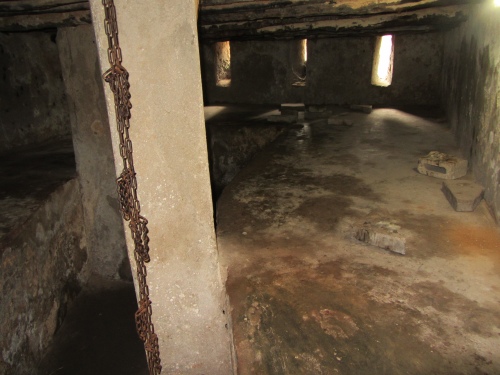
Slave Chamber - Give up Hope All Who Enter Here
|
Our guide around the cathedral was Martin, who began by taking us down a stone staircase. As we descended he explained how during the reign of the Omani Arabs in the early 19th century, Zanzibar was the main slave trading point of East Africa. Slaves bought and caught on the mainland were shipped to Zanzibar, where they were re-sold and further transported to Seychelles, Mauritius, Oman and Persia. In those days, the slave market of Stone Town was easily accessible by sea, as the artificial extension of land had not occurred yet. Fifteen chambers under the earth were used for storing the slaves before being taken to market. Today only two of the 15 chambers are accessible. They are located under the St. Monica's Hostel, which was built in 1890 above the slave chambers. The house was used to accommodate teachers, nurses and nuns working at the Universities' Mission to Central Africa and in the missionary hospital in the extension of the building. The chambers had low ceilings and tiny windows. Sea water running through the damp rooms functioned as the toilet. The slaves were chained on the bare stone, each chamber holding 75 men/women/children or 50 men. Many did not survive the cramped living conditions due to exhaustion and sickness. It was not just disease that was a threat in these filthy conditions, the slaves were crammed into the chambers regardless of tribe, and the resulting inter-tribal violence would lead to more deaths and injury. We stood in one of the chambers, a dark, dingy, airless tomblike room on which the slaves were manacled up to five deep on large stone slabs. I found it hard to imagine 12 people struggling to survive in this cell, never mind up to 75. I wondered at how many poor souls suffered misery passing through these chambers, and I winced at the pain, terror, suffering and death that had taken place here on a daily basis; it was beyond my comprehension.

Slave Monument
|
Outside in the bright daylight, Martin showed us an artwork sunken in the ground: life-size statues of slaves, bearing original chains recovered from Bagamayo, the Slave Monument sculpted by Swedish artist Clara Sornas. It features five slaves placed in a pit: men, women and children. They have a collar around their neck and they are chained one to the other, a very powerful, evocative creation.
Martin then took us into the cathedral, awash with Italian marble, carved mahogany, and back plates made from Zambian copper. Legend has it that former slaves in need of work were employed in the cathedral's construction, and made one mistake. The supervisor, Steere, was called away on business and returned to find 12 pillars had been erected upside down. He decided to leave them, and so they remain. The altar of the cathedral stands on the spot where a large tree grew, the whipping post, marked out at the altar by a white marble circle surrounded by red to symbolise the blood of the slaves. Slaves were tied to this and then whipped to indicate their strength and hardness. Those who cried out least were considered the strongest, and were sold for higher prices.

Fruit and Vegetable Stalls at Darajani Market
|
Staying on the significance of trees in the cathedral, a wooden cross was made from the tree beneath which the famed explorer and anti-slavery crusader Dr. David Livingstone's heart was buried. He died at the village of Dhitambo in Zambia on 2 May 1873 while searching for the source of the Nile. Two of his loyal companions, Susi and Chumah, removed his heart and buried it under the tree at the spot where he died; he had always requested that if he died in Africa, part of his body be buried in the land he loved. They dried his body in the sun for two weeks before carrying it back to Zanzibar.
Outside the cathedral stood a jojoba tree, which Martin described as "the weeping tree for slaves".
Moving on from one market to another, we headed across to Darajani Market in order for Dan to barter for a selection of spices. The market is no place for the faint-hearted, with fish being hacked and thrashed about, and unrecognisable carcasses of animals hanging up acting host to squadrons of flies. The din and smell in these halls belonged to another world. The fruit, vegetable and spice stalls outside are far more colourful and interesting. Then there are stalls selling shoes, metal ware, junk and even beds. For some reason I found stalls all across Tanzania selling very large king size beds, all to the same template, and all purely functional with disregard to aesthetics. The quality of the beds left a lot to be desired, with not many steps between pallets and final product.
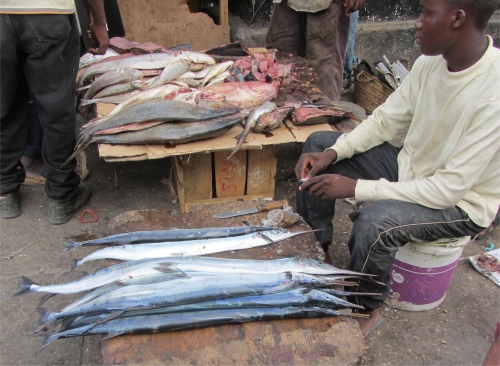
Fish Stall
|
As Dan scouted around the dozens of spice stalls, a pattern developed. As soon as he was spotted dwelling to examine a particular item, all traders for several metres around would converge on him uttering, "Please look at my stall," "I have the best spices," "We have the cheapest spices," "What do you want to pay?" and so on. A thick skin is a necessity.
Mission completed, we met up with Sally at Livingstone's, she had been chilling out here all the time, a good place for people watching. Later in the evening, Dan's last evening on the island, we headed to the sea front, where Dan chose the Monsoon Restaurant for his last evening meal here. The waiter was in a definite grumpy mood, which was unusual on this friendly island. Perhaps he was the brother of the grumpy man who manned the desk at the Mnarani Natural Aquarium in Nungwi. In addition, the food was so-so, in fact Dan's steak seemed to have been cooked by starlight only, such was its state of rareness. But we survived, and headed back to our usual haunt, Livingstone's, for a couple of cocktails to round off the day.
The heat of the day was still omnipresent, and not a breath of air stirred from the sea. A drop of ten degrees in temperature would have been welcome. Night ferries plied out from the ferry terminal, and the throbbing engines could be heard long after they were lost to sight. A selection of excellent blues music drifted out from the depths of the building. Bliss. There was a moment of hilarity when Dan picked a cocktail which could be best described as an acquired taste.
It was late, or better said late for us early birds, and we were all shattered. Reluctantly, we left the sweet combination of blues and cocktails by the sea, and headed back to Flamingos, only to find the front door closed, and our keys were held at reception. Boy did I curse. Sally had the presence of mind to yank at the door angrily, which summoned the night receptionist from his slumbers and the doors creaked open for us. It had been a long day.

























